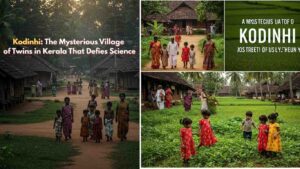Kodinhi – The Village of Twins (Kerala)

Nestled in the lush greenery of Kerala, India, Kodinhi stands as a mystery that continues to baffle scientists, geneticists, and visitors alike. This small, serene village in the Malappuram district of Kerala has become globally recognized for one unusual phenomenon: its extraordinarily high rate of twin births. Kerala is unlike any other village in India, or perhaps even the world, and it has been the center of both fascination and research for years.
The Enigma

The story of Kerala isn’t rooted in mythology or folklore but in startling, documented facts. With just over 2,000 families, Kodinhi has reported more than 400 twin births in recent decades. This number is abnormally high when compared to the global average of twin births, which stands at about 12 per 1,000 deliveries.
The twin phenomenon of Kerala came to public attention in the early 2000s when media outlets started reporting on the increasing number of twin births in the village.
The Statistical Mystery

It is not just the sheer number of twins that is baffling; it’s also the consistency of twin births across generations. Families in Kodinhi report twins being born for two or three generations back. What’s even more fascinating is that women from Kodinhi who marry outside the village and move elsewhere often continue the trend by giving birth to twins. In a country where the average twinning rate is extremely low, Kodinhi emerges as a statistical outlier. Some estimates place the twinning rate in Kodinhi (Kerala)
at nearly 45 per 1,000 births. That is staggering, particularly when no major lifestyle or environmental differences have been documented to account for such a high incidence.
Scientists and Research

One of the most prominent studies was led by Dr. Krishnan Sribiju, who has been monitoring the birth trends in Kodinhi for over a decade. He and his team found no significant external factors such as diet, water, or climate that could explain the trend. Instead, he suspects a genetic anomaly may be the reason behind Kodinhi’s phenomenon.
Despite this, no single conclusive explanation has emerged. The mystery of Kodinhi remains intact, continuing to attract curious minds from around the world.
The Twins and Their Lives in Kodinhi (Kerala)
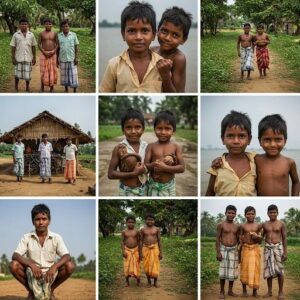
Twins in village live regular lives, but their experiences are far from ordinary. Schools in village are filled with pairs of twins in the same class, sometimes causing confusion among teachers and classmates. Many twins in village dress alike and are deeply connected to each other, exhibiting the close bond that twins are known for.
The parents in Kodinhi take pride in their twins, often celebrating their uniqueness. In fact, Kodinhi has its own association for twins, believed to be the first of its kind in India. The association organizes annual events, bringing twins from across Kodinhi and other parts of the world together. These events serve not just as community celebrations but also as platforms for research and dialogue on the unique characteristics of Kodinhi.
Global Comparisons to Kodinhi
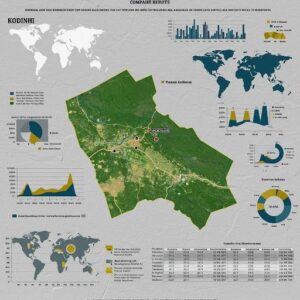
Kodinhi is not the only place on Earth where twinning occurs at abnormal rates. Other villages like Igbo-Ora in Nigeria and Cândido Godói in Brazil have also recorded high twin birth rates. However, Kodinhi stands out due to the consistency and scale relative to its small population.
Unlike Igbo-Ora, where diet—particularly the consumption of yams—has been proposed as a contributing factor, no such dietary explanation exists for Kodinhi. Residents of Kodinhi follow the typical Kerala cuisine, with no significant deviation that could influence fertility patterns.
This makes Kodinhi even more enigmatic when compared to other “twin towns.” While other explanations might partially account for high twinning rates elsewhere, Kodinhi continues to defy all scientific and environmental logic.
Cultural and Social Impact of Kodinhi
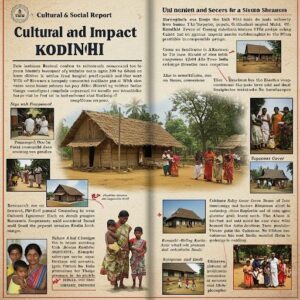
Living in Kodinhi means being a part of something extraordinary. The village has embraced its unique identity, turning it into a source of pride rather than bewilderment. The presence of hundreds of twins in a small village like Kodinhi has led to cultural shifts, from the way people name their children to how schools operate.
Some residents believe that the abundance of twins is a divine blessing, further adding a layer of mysticism to the scientific puzzle.
Education and Awareness in Kodinhi
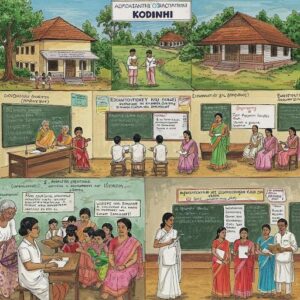
Efforts have been made in Kodinhi to promote education and health awareness, especially concerning maternal and child health. The villagers have shown keen interest in collaborating with researchers and participating in surveys to uncover the secrets behind their rare status.
Women’s health initiatives in Kodinhi are being supported by local government and NGOs, especially since twin pregnancies require more medical attention. Clinics in Kodinhi have started offering special support for mothers expecting twins.
The people of Kodinhi are actively contributing to their own scientific narrative, turning what could have been a curious anomaly into a meaningful social movement for understanding and progress.
Tourism and Media Attention on Kodinhi
With rising interest in unusual and mysterious destinations, Kodinhi has found a place on the map of curious travelers. Tourists come to Kodinhi not only to witness its natural beauty but also to experience the village of twins firsthand.
Media from around the world have covered Kodinhi, including National Geographic, BBC, and Indian news channels. Documentaries, YouTube videos, and social media reels have added to the growing curiosity around Kodinhi.
Local businesses have also started to embrace this fame. Shops selling twin-themed souvenirs, cafes named after twins, and twin-paired tour guides add a charming and quirky dimension to the Kodinhi experience.
Challenges Faced by Kodinhi
Despite the fame and wonder, Kodinhi faces its own challenges. Healthcare infrastructure needs to improve to handle the unique needs of twin pregnancies. There’s also a need for greater scientific funding and research into the phenomenon of Kodinhi.
The twin identity of Kodinhi should be used not just for tourism and headlines, but also to bring in better healthcare facilities, scientific collaboration, and educational development.
The Future of Kodinhi
As research continues, the world watches Kodinhi with fascination. Whether the cause of the twin phenomenon in Kodinhi is genetic, environmental, or a combination of unknown factors, one thing remains clear: Kodinhi is a living mystery.
With growing awareness, better healthcare, and continued scientific interest, Kodinhi is set to remain a beacon of curiosity and wonder. The children of Kodinhi, many of them twins, are growing up with an identity that connects them not just to each other, but to a global conversation about nature, genetics, and mystery.
Kodinhi is not just a village; it is a question mark in the world of science and a shining example of community spirit. Its story continues to unfold, adding new layers to the enigma and drawing in more minds determined to understand the phenomenon.
1. The Secret Diaries of Local Midwives
Long before the phenomenon caught the attention of the world, it was the village midwives who first noticed something strange. According to old women in the community, even as far back as the 1940s and 1950s, they were delivering twins at an unusually high rate. While no official records existed then, handwritten diaries of a few elder midwives still exist in some households, containing tally marks and notes like “two boys – same face,” or “girl and boy twins, strong heartbeat.”
2. Water That Remembers?
Many villagers claim, half-jokingly, that the water in Kodinhi has “memory.” They refer to a specific well on the western side of the village, whose water is said to taste slightly sweet and has a “soothing effect” on pregnant women. Some women, especially elders, believe drinking from this well increases the chances of having twins.
Interestingly, researchers from Hyderabad and Germany who visited Kodinhi took samples from that well — but found nothing conclusive. No chemicals, no hormonal traces, nothing unusual. Still, the legend persists. Some even believe the water may have energetic or vibrational properties that science hasn’t yet understood.
Could this be a coincidence, or is this well holding part of the secret?
3. The Story of the “Blue House”
An old, worn-down house near the mosque is known locally as “The Blue House of Twins.” For nearly 60 years, every generation born into that family has had a pair of twins. The current owner, Hameed, is a twin himself, and his two daughters are also twins.
Neighbors whisper stories of how the family might be “carrying something ancient in their blood.” There are even rumors, dismissed by the family, that the house was built on a site blessed by a traveling Sufi saint centuries ago. He reportedly blessed the land to be “forever fertile.”
While the tale may sound mythical, the generational pattern of twins from one house is real — and has stumped genetic researchers.
4. Unusual Dreams Shared Among Twins
Multiple twins in Kerala have described experiencing shared dreams, especially during childhood. Some describe having identical dreams on the same night — often about being lost together, climbing the same tree, or walking along the same riverbank.
Parents initially dismissed these claims as “childhood stories,” but once local teachers began collecting data for research, the pattern became clear. In a survey conducted unofficially by a school principal, over 20 sets of twins claimed recurring identical dreams, especially around ages 5–10.
5. Migration Effects: Do Twins Continue the Pattern?
One hidden aspect few talk about is how the phenomenon travels with the people. Several families who moved from There to Dubai, Mumbai, and even Malaysia have continued to produce twins — despite changing diets, climates, and medical environments.
This suggests that the twinning mystery might not be entirely environmental. If the high twinning rate persists outside the village, it adds credibility to the genetic or hereditary theory. Yet, the specific genes responsible have not yet been isolated.
Even more mysteriously, some say non-Kodinhi women who marry into the village also end up giving birth to twins — a pattern seen in at least 30 documented cases. This could mean the “trigger” might lie in both male and female genetic interactions.
6. Whispered Theories of an Ancient Ritual
Elders speak quietly of an ancient fertility ritual that was once common in the area, possibly hundreds of years ago. Though now lost to time, the ritual was believed to be performed during full moons on the banks of a nearby stream — invoking blessings for healthy, abundant offspring.
There are no written records of this ritual, and many younger villagers don’t believe it existed. But local folk songs and oral traditions speak of women offering milk, herbs, and turmeric to the earth under moonlight.
Could this ritual, long forgotten, have awakened some ancestral genetic imprint that remains active even now?
7. The Myth of the “Mirror Curse”
Among the stranger stories is one that children whisper during playtime — the Mirror Curse. The tale says that a wandering mendicant once cursed the village, saying “you will see yourself everywhere you go.” It was originally meant to shame a wealthy merchant for his pride.
Over time, this folklore turned into the eerie playground myth that explains why everyone in the village sees a “copy” of themselves — in their sibling.
While clearly mythological, this story reflects how local imagination tries to make sense of the twinning through culture and fable.
8. When Triplets Appear
Though twins are common, triplets are extremely rare — but not absent. Over the last two decades, there have been five known cases of triplets born in the village. Medical experts from Kochi and Bangalore arrived to examine the babies and confirmed that the probability of naturally conceived identical triplets is less than 1 in 100,000.
9. Astrological Alignments?
Some local scholars have looked at astrological charts for children born in Kerala and claim that most twin births seem to cluster around certain lunar cycles — especially during the waxing moon. Though purely speculative, these astrological theories have been noted by some researchers for cultural context.
One astrologer even proposed that the geographical coordinates of Kerla align with a specific “node” in South Indian astrology charts — which he believes might increase the likelihood of soul-pair births.
10. Silence of the Genes – What’s Not Being Shared
Some villagers privately express frustration that despite being studied for years, the scientific findings are rarely shared with the community. Blood samples, interviews, and personal data are often collected by researchers, but few return to explain their conclusions.
There’s a growing sentiment that deserves more transparency, more benefit-sharing, and perhaps even community-based research. After all, the village isn’t just a laboratory — it’s a living place of culture, history, and people.







